Aging skin is not only driven by environmental factors, therefore, a look at skin physiology gives professionals ample information through which they can care for different indications involved with aging skin for the young and old. The vast skin care industry can be overwhelming and misunderstood when seen at a glance and, because technology in skin care directly reflects the changes seen in today's world, skin care of 2017 needs to be acknowledged differently than it was 10 or 20 years ago.
Skin care professionals should delve deeper – acting as both consumers and practicing clinicians – into the features and benefits of products available to this generation to better understand and anticipate future technological advancements. They should be prepared for the upcoming decades with regards to wellness opportunities that present within life itself, as well as in their skin care techniques and habits. Once people know where they want to go with their skin care practice or regimen, they will be able to make a plan for how to get there. Understanding the preventative, maintenance, and reversal philosophy of successful skin care is essential for caring for the essential barrier to the outside: the skin.
 Prevention
Prevention
It is crucial to establish ongoing training in modern techniques and bring in technologically advanced product lines to customize skin care for professional and home care therapies. Analyzing the lifestyle and visible environmental indications on the skin will help the professional and other staff members map out a relevant and individualized plan for each client. When effectively and efficiently coordinating a skin care regimen, it is helpful if the professional understands the daily activities of the person they are working with and consider themselves to be that person's skin care advocate. Help each client understand the similarity between skin care and exercise – when they go to the gym and work out with a personal trainer, there is commitment, a plan, follow through, and accountability. Likewise, skin care professionals are their clients' skin trainer and the spa is a skin gym with a commitment (showing up for appointments and scheduling in advance at the end of each appointment), plan (short-term and long-term goals), follow through (homecare regimen), and accountability (communication between the professional and client in-between appointments and an expectation of results and a solution-focused feel for the next appointment).
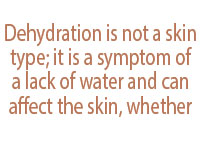 Dry skin occurs due to a lack of water in the skin, not a lack of water. The basement of the skin, the dermis, is like the basement of a house with pipes and a hot water tank; without a healthy dermis, the health of the epidermis is compromised and, visually, this condition can be seen in the stratum corneum. Androgens regulate the sebaceous glands, thus hormonal shifts over time change skin from dry to oily. Professionals can only regulate and control a client's skin type through hormonal regulation; skin type cannot be changed. Clients are genetically predisposed to oilier or drier skin as skin cells are coded at birth. Irregular or chemical-induced hormonal changes, product ingredients, and external and internal factors all play a role in influences that are changing the body's overall hormone picture.
Dry skin occurs due to a lack of water in the skin, not a lack of water. The basement of the skin, the dermis, is like the basement of a house with pipes and a hot water tank; without a healthy dermis, the health of the epidermis is compromised and, visually, this condition can be seen in the stratum corneum. Androgens regulate the sebaceous glands, thus hormonal shifts over time change skin from dry to oily. Professionals can only regulate and control a client's skin type through hormonal regulation; skin type cannot be changed. Clients are genetically predisposed to oilier or drier skin as skin cells are coded at birth. Irregular or chemical-induced hormonal changes, product ingredients, and external and internal factors all play a role in influences that are changing the body's overall hormone picture.
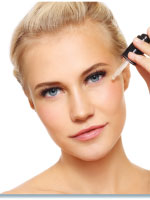 Adult acne is much harder to treat because the skin is unhealthy and older. Adult skin tends to be vitamin-damaged and sun damaged; time is working against older skin because the telomeres in the skin are shorter. It is important to include anti-inflammatory care in an aggressive acne-focused regimen. Accutane and Retin-A are highly exfoliating medications that the client must be off of for a minimum of two weeks – typically closer to two months – before any treatment can be performed. Furthermore, birth control pills take away vitamins and minerals from the body and induce hormonal changes. Because sebaceous glands produce sebum for lubrication and protection, dry skin then has less lubrication and protection. When barrier function is compromised (as it is in drier, older skin), the skin is more prone to skin disorders and sensitivity. Consider the differential of clients living in the desert, where people with oily skin present with a different form of dryness than genetically predisposed dry skin. This desert dryness is actually chronic dehydration at a cellular level. Sweat glands are also in the dermis and regulate moisture in the body. There are two types of these sweat (sudoriferous) glands: eccrine and apocrine; both are regulated by the nervous system. Eccrine glands end in the pores and are found all over the body, particularly on the soles of the feet, palms, and forehead. Apocrine glands are found around areas of hair, such as the armpits, and end in hair follicles instead of pores.
Adult acne is much harder to treat because the skin is unhealthy and older. Adult skin tends to be vitamin-damaged and sun damaged; time is working against older skin because the telomeres in the skin are shorter. It is important to include anti-inflammatory care in an aggressive acne-focused regimen. Accutane and Retin-A are highly exfoliating medications that the client must be off of for a minimum of two weeks – typically closer to two months – before any treatment can be performed. Furthermore, birth control pills take away vitamins and minerals from the body and induce hormonal changes. Because sebaceous glands produce sebum for lubrication and protection, dry skin then has less lubrication and protection. When barrier function is compromised (as it is in drier, older skin), the skin is more prone to skin disorders and sensitivity. Consider the differential of clients living in the desert, where people with oily skin present with a different form of dryness than genetically predisposed dry skin. This desert dryness is actually chronic dehydration at a cellular level. Sweat glands are also in the dermis and regulate moisture in the body. There are two types of these sweat (sudoriferous) glands: eccrine and apocrine; both are regulated by the nervous system. Eccrine glands end in the pores and are found all over the body, particularly on the soles of the feet, palms, and forehead. Apocrine glands are found around areas of hair, such as the armpits, and end in hair follicles instead of pores.
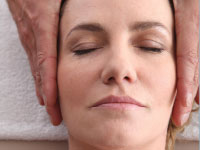 Skin care professionals can energize the sweat glands because the skin is a live organ. Serums with hyaluronic acid/sodium hyaluronate (botanical form) are essential tools for professional and homecare use. Serums with hyaluronic acid/sodium hyaluronate can be considered a powerful line of defense for professionals to use and to recommend. Professionals should send the client home with one of the water magnet-based serums. If the client's skin is dry, they need to use serums under the lipid ceramides of heavy creams. If their skin is dehydrated, keep in mind that dehydration is not a skin type; it is a symptom of a lack of water and can affect the skin, whether it is oily or dry, making it more sensitive and often itchy. Dehydrated skin that is either self-induced or environmental is an invisible war that skin care professionals must fight.
Skin care professionals can energize the sweat glands because the skin is a live organ. Serums with hyaluronic acid/sodium hyaluronate (botanical form) are essential tools for professional and homecare use. Serums with hyaluronic acid/sodium hyaluronate can be considered a powerful line of defense for professionals to use and to recommend. Professionals should send the client home with one of the water magnet-based serums. If the client's skin is dry, they need to use serums under the lipid ceramides of heavy creams. If their skin is dehydrated, keep in mind that dehydration is not a skin type; it is a symptom of a lack of water and can affect the skin, whether it is oily or dry, making it more sensitive and often itchy. Dehydrated skin that is either self-induced or environmental is an invisible war that skin care professionals must fight.
There is also a genetic difference between oily and dry skin that relates to the size of the sebaceous glands. Oily skin sebaceous glands are much larger than those of dry skin, so they produce much more oil and the follicle becomes enlarged. Dry skin presents as small, invisible pores.
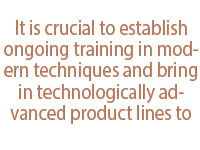 A few other major tools to energize skin include facial massage, exfoliation, currents, heat, and chemicals. Facial massage is highly effective when performed properly based on skin type and conditions. Acneic skin responds nicely to acupressure, feeding blood to spots of bacteria and congestion. Dry, aging skin responds well to the five traditional techniques of facial massage. Inflammatory skin conditions, such as rosacea, do best with lymphatic drainage massage. Regardless of the massage technique, the skin does well when professionals use a proper massage medium. Hydrophilic oil infused with antioxidants will give the skin the proper slip and glide without congesting it or disturbing the healthy acid mantle. The skin is akin to thousands and thousands of moving microscopic boxes and, since it is a live organ, the external manipulation by touch, as well as the internal facilitation of change byproducts that affect the look and feel of the skin. If both the professional and the client use proper products, the skin remains healthy and skin regeneration and rejuvenation is not slowed down.
A few other major tools to energize skin include facial massage, exfoliation, currents, heat, and chemicals. Facial massage is highly effective when performed properly based on skin type and conditions. Acneic skin responds nicely to acupressure, feeding blood to spots of bacteria and congestion. Dry, aging skin responds well to the five traditional techniques of facial massage. Inflammatory skin conditions, such as rosacea, do best with lymphatic drainage massage. Regardless of the massage technique, the skin does well when professionals use a proper massage medium. Hydrophilic oil infused with antioxidants will give the skin the proper slip and glide without congesting it or disturbing the healthy acid mantle. The skin is akin to thousands and thousands of moving microscopic boxes and, since it is a live organ, the external manipulation by touch, as well as the internal facilitation of change byproducts that affect the look and feel of the skin. If both the professional and the client use proper products, the skin remains healthy and skin regeneration and rejuvenation is not slowed down.
When improper products are used, the skin thinks it no longer needs to work; therefore, use the right products for each skin type and indication.
Another tool, exfoliation, includes manual manipulation, like massage and scrubs; enzymatic exfoliation, such as pumpkin or papaya enzymes; chemical exfoliation, including the use of alpha hydroxy acids and beta hydroxy acids; and a combination treatment using enzymes and chemicals or adding modalities such as microdermabrasion. Currents (galvanic) and heat are additional tools for energizing the skin. Additional examples of tools used to energize the skin would be calming or soothing serums or masks made of chemical or enzymatic combinations.
The aging process is inevitable, but good skin care is deliberate – it needs to be an intentional and educated effort to help the next generation know how to look and feel well. The health of the body and mind is directly linked to the health of the skin. Professionals should be part of the change they wish to see in the wellness part of their niche in the skin care world – their influence as a professional will transform the way future generations look at their skin and what goes into their bodies.
For younger clients coming at the urging of a parent, education of both the client and the parent is critical for the longevity and success of the relationship. Parental influence and leading by example goes a long way towards how well a younger client will stay with a skin care regimen and how well they will embrace change and growth in their skin care regimen as they age. Younger clients will make decisions based on their own experiences in life and can be influenced by their peers, but even more so from watching their parents. Parents have a persuasive influence that will guide their children to look after their skin health and make smart decisions as they age. Encourage clients
with children, or those who are often around children, to be that ongoing example. Putting on educational seminars, for example, for youth club organizations will help instill the benefit of good skin care techniques from an early age.
If professionals still need to find their niche, they should spend time figuring it out. Helping clients prevent, maintain, and reverse aging skin requires the professional to understand their strengths and weaknesses. When they have established the scope of their ability to treat and care, they will be able to make a difference – one client at a time.
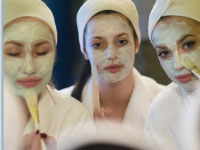 Maintenance
Maintenance
There is an abundance of excellent products and numerous regimens available for people to take care of their bodies; the ways to maintain a healthy appearance are endless. With the information and resources that are currently available, it is possible for people to sustain nice skin. Once there is interest by the client, he or she will buy into a solid skin care regimen; a discussion about consistency is the next step and a significant part of a successful maintenance program. While prevention includes ingredients that protect the skin from the environment and biological aging, maintenance involves ingredients that keep the skin supple, hydrated, healthy, and clean on an ongoing basis. Products always have a "best by" shelf life and the best or freshest products will only make a difference when applied in the right way within a realistic period of time.
 Botanicals are incredibly effective as part of all aspects of skin care and in a maintenance routine to reduce inflammation and, therefore, enhance active ingredient efficacy. Natural preservatives – such as rosemary and purely extracted tea tree oil – sodium hyaluronate, and ginkgo biloba work together to keep the skin clean, oxygenated, and hydrated. Grape stem cells responsible for regenerating the skin by acting as free radical-scavenging antioxidants target unidentified toxins and allow the body to remove the sludge and stickiness within the cells; this process allows them to work faster and better with their regenerating properties. Apple stem cells bring the reality of reducing fine lines and wrinkles to the forefront of botanical skin care through their rejuvenating characteristics – helping cells to stay as young as possible for as long as they live.
Botanicals are incredibly effective as part of all aspects of skin care and in a maintenance routine to reduce inflammation and, therefore, enhance active ingredient efficacy. Natural preservatives – such as rosemary and purely extracted tea tree oil – sodium hyaluronate, and ginkgo biloba work together to keep the skin clean, oxygenated, and hydrated. Grape stem cells responsible for regenerating the skin by acting as free radical-scavenging antioxidants target unidentified toxins and allow the body to remove the sludge and stickiness within the cells; this process allows them to work faster and better with their regenerating properties. Apple stem cells bring the reality of reducing fine lines and wrinkles to the forefront of botanical skin care through their rejuvenating characteristics – helping cells to stay as young as possible for as long as they live.
Other critical components to healthy skin care involve diet, exercise, and body hydration. Clients should follow a controlled diet and exercise plan. Hygiene plays a very important role and must be recognized and followed, as well. These are important steps to start and maintain in regard to a preventative program. Vitamin D from the sun is beneficial, but can also be harmful, therefore, it is a good idea for professionals to consider ways to incorporate vitamin D into their clients' skin care therapies and regimens. Ultraviolet light helps prevent seasonal affective disorder, is important for health, and is antibacterial and antimicrobial. Infrared light relaxes and is deep penetrating into the muscles. In the morning and the afternoon, there is more ultraviolet light, which is the best time for outdoor activities from a skin care perspective. During the middle of the day, especially in countries closer to the equator, the infrared light is prevalent and most damaging.
 Proper antioxidants within the body complement stable and purely extracted antioxidants that are applied externally. The early use of quality, efficient products to take care of the skin is of the utmost importance. Clients should protect their skin from overexposure to sun and areas that are over-polluted both inside and outside of their home. They should make use of professional advice and consultations in regards to products and treatments and be sure to follow those instructions at all time.
Proper antioxidants within the body complement stable and purely extracted antioxidants that are applied externally. The early use of quality, efficient products to take care of the skin is of the utmost importance. Clients should protect their skin from overexposure to sun and areas that are over-polluted both inside and outside of their home. They should make use of professional advice and consultations in regards to products and treatments and be sure to follow those instructions at all time.
Professionals can use enzymes when working on a client's skin care regimen. Enzymes are more advanced than scrubs, which clients can use at home. Once the cleansing steps are completed and the skin has been toned to balance the pH level, exfoliation will brighten and resurface the dry, dull, tired skin that is representative of the aging process. Enzyme-focused exfoliants and gentle, yet effective, manual scrubs with waxes or jojoba beads balance out the sometimes over-aggressive removal of the dead keratinocyte layer seen in chemical-based exfoliation and harsher scrubs. All of these exfoliants can be helpful to stimulate blood circulation, a necessary part of an anti-aging treatment. When addressing the maintenance needs of the client, consider using a skin scope (black light, which is larger and more expensive) or a Wood's lamp (hand-held skin scope) to assess the change in the skin and visible indications as the professional treatments are considered.
 Reversal
Reversal
Mature clients should be made aware that a strict regimen should be followed. Never allow the client to think that not using the products generously will show success. Clients must show discipline and consistency for a successful reversal program. When a client commits to the sage advice shared by a skin care professional, aging skin can be transformed. Reversal can involve stem cells to stimulate and re-activate healthy function in cells. Antioxidants are free radical scavengers, therefore vitamin C, grape stem cells, and other antioxidant-rich powerhouse ingredients are critical for skin to identify and flush sticky, troublesome toxins.
A person's lifestyle decisions can also either reverse or accelerate signs of aging. Visible serious signs of aging come from unprotected skin exposure, even just a few minutes' worth. Exposure to harmful ultraviolet rays breaks down the skin's elastin and collagen and, without these supportive tissues, skin matrix loses its flexibility and strength and starts to sag and wrinkle. Smoking is a strong accelerant of the natural aging process, as it restricts the healthy oxygenation of the blood, restricting blood flow to the skin and making it difficult for skin cells to reach the oxygen and nutrients necessary to regenerate.
When addressing the reversal needed in the treatment of aging skin, it is important to compare damaged and healthy characteristics present in skin to determine the proper ingredients needed to reverse the damage done. The stratum corneum will present damage as thick, dehydrated skin that is visible to the naked eye. A healthy stratum corneum is thinner and has a healthy tone and feel. Cells that are damaged are misshapen and disorganized at a microscopic level and healthy cells appear full and new. Melanin, when damaged, is present in excess in random locations and freckles and age spots are in abundance. Correct pigment and evenly distributed melanin exemplifies healthy melanin in the skin. When collagen and elastin is weak and damaged, the reason is typically ultraviolet rays and free radicals attacking the skin. Free radicals are unbalanced oxygen molecules that are constantly attacking skin cells. Healthy collagen and elastin allows for the supporting skin structure to remain strong and resilient. Stabilized oxygen is good for the skin, but, when oxygen is not stabilized, it is damaging to skin structure.
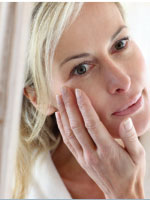 Science suggests that genetics are 20 percent of the aging problem. A person's environment, lifestyle, and biological disorders comprise the rest. People are creating a society that overuses harsh chemicals, therefore unbalancing and abusing the critical barrier function of the skin and often creating degradation below the epidermis. For example, Retin-A plays an important role for certain skin indications, including acne and pigmentation, but it is creating side effects as it brings the turnover of the skin from 28 days down to 10 to 14 days. Psoriasis has a cycle of three to seven days. The flipside of more natural powerful ingredients involves the reversal of skin indications; they are important in the prevention and maintenance side of skin care. Mushrooms bring high levels of vitamin D and, as a result, immune support to the skin. When skin is sensitive, it is often actually weak skin or sensitized skin in most cases. Skin care professionals rarely see skin that is truly the textbook definition of sensitive. Professionals cannot change sensitive skin, as the immunity needs to be increased for this skin type. Mushrooms, with their propensity to heal, will help internally and externally. Olives have powerful vitamin A for healing. Almonds are used as an emollient and bring a hydrating presence to the table. Tomatoes contain lycopene and provide ultraviolet defense. Raisins are high in antioxidants. Sensitive skin will benefit from extracts from all of these active ingredients for all aspects of skin care.
Science suggests that genetics are 20 percent of the aging problem. A person's environment, lifestyle, and biological disorders comprise the rest. People are creating a society that overuses harsh chemicals, therefore unbalancing and abusing the critical barrier function of the skin and often creating degradation below the epidermis. For example, Retin-A plays an important role for certain skin indications, including acne and pigmentation, but it is creating side effects as it brings the turnover of the skin from 28 days down to 10 to 14 days. Psoriasis has a cycle of three to seven days. The flipside of more natural powerful ingredients involves the reversal of skin indications; they are important in the prevention and maintenance side of skin care. Mushrooms bring high levels of vitamin D and, as a result, immune support to the skin. When skin is sensitive, it is often actually weak skin or sensitized skin in most cases. Skin care professionals rarely see skin that is truly the textbook definition of sensitive. Professionals cannot change sensitive skin, as the immunity needs to be increased for this skin type. Mushrooms, with their propensity to heal, will help internally and externally. Olives have powerful vitamin A for healing. Almonds are used as an emollient and bring a hydrating presence to the table. Tomatoes contain lycopene and provide ultraviolet defense. Raisins are high in antioxidants. Sensitive skin will benefit from extracts from all of these active ingredients for all aspects of skin care.
By building a foundation of knowledge and wisdom, the professional is well equipped to bring this happy and satisfied smile back to their client. A few character folds and wrinkles only add to good looks, so never try to eliminate them completely; while working on the more significant signs of aging skin, allow clients to give themselves grace in other ways and focus on softening them with anti-inflammatory products and light massages.
Skin is alive, so it should be treated like it is. Paying attention to the prevention, maintenance, and reversal of skin is about more than just good skin care; it is about good lifestyle habits that can be passed on to others. Sunscreen, botanical stem cells, hydration, cleansing, and proper exfoliation, along with technologically advanced modalities, will help and care for the most challenged aging skin conditions. Whether a simple routine for prevention, a customized maintenance system that can also be focused on preventing future damage to the skin, or a more advanced system for reversal of past damage, proper skin care makes a difference.
 Dr. Dieter Kuster is the founder of CA BOTANA International. He has developed over 3,000 products for the cosmetics industry including the in-house brands Doctor D. Schwab, Sea Enzyme, and Ambrosia Aromatherapy. One of his breakthrough achievements is the development of the highly acclaimed molecular penetrator Alphasomes®, an advanced delivery system to increase product effectiveness. His other specialties include target-specific enzymes and superior peptide technology. During his 50-plus years of experience, he has authored many articles for magazines and trade publications and is a sought-after lecturer and speaker for the beauty industry on an international level.
Dr. Dieter Kuster is the founder of CA BOTANA International. He has developed over 3,000 products for the cosmetics industry including the in-house brands Doctor D. Schwab, Sea Enzyme, and Ambrosia Aromatherapy. One of his breakthrough achievements is the development of the highly acclaimed molecular penetrator Alphasomes®, an advanced delivery system to increase product effectiveness. His other specialties include target-specific enzymes and superior peptide technology. During his 50-plus years of experience, he has authored many articles for magazines and trade publications and is a sought-after lecturer and speaker for the beauty industry on an international level.
 A native San Diegan and UCLA alumna, Tami Assaf gained experience from the medical laser industry and is currently an aesthetician for clinics in La Jolla, Calif. and Palm Desert, Calif. She also consults for a variety of projects within the aesthetic industry. As an educator for CA Botana, Assaf shares her love for skin care techniques and the science behind getting great results with fellow skin care professionals, as well as students in the industry.
A native San Diegan and UCLA alumna, Tami Assaf gained experience from the medical laser industry and is currently an aesthetician for clinics in La Jolla, Calif. and Palm Desert, Calif. She also consults for a variety of projects within the aesthetic industry. As an educator for CA Botana, Assaf shares her love for skin care techniques and the science behind getting great results with fellow skin care professionals, as well as students in the industry.
Want to read more?
Subscribe to one of our monthly plans to continue reading this article.